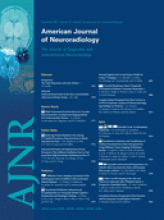Review ArticleReview Article
Open Access
Fluid-Attenuated Inversion Recovery Vascular Hyperintensities: An Important Imaging Marker for Cerebrovascular Disease
A. Azizyan, N. Sanossian, M.A. Mogensen and D.S. Liebeskind
American Journal of Neuroradiology November 2011, 32 (10) 1771-1775; DOI: https://doi.org/10.3174/ajnr.A2265
A. Azizyan
N. Sanossian
M.A. Mogensen

References
- 1.↵
- Schellinger PD,
- Fiebach JB,
- Hacke W
- 2.↵
- Warach S
- 3.↵
- Cosnard G,
- Duprez T,
- Grandin C,
- et al
- 4.↵
- Kamran S,
- Bates V,
- Bakshi R,
- et al
- 5.↵
- Maeda M,
- Yamamoto T,
- Daimon S,
- et al
- 6.↵
- Toyoda K,
- Ida M,
- Fukuda K
- 7.↵
- Tsushima Y,
- Endo K
- 8.↵
- Iancu-Gontard D,
- Oppenheim C,
- Touze E,
- et al
- 9.↵
- Sanossian N,
- Saver JL,
- Alger JR,
- et al
- 10.↵
- Lee KY,
- Latour LL,
- Luby M,
- et al
- 11.↵
- Sanossian N,
- Ances BM,
- Shah SH,
- et al
- 12.↵
- Schellinger PD,
- Chalela JA,
- Kang D-W,
- et al
- 13.↵
- Goldstein LB,
- Adams R,
- Becker K,
- et al
- 14.↵
- Jo KD,
- Saver JL,
- Starkman S,
- et al
- 15.↵
- 16.↵
- Liebeskind DS
- 17.↵
- Liebeskind DS,
- Hao Q,
- Sanossian N,
- et al
- 18.↵
- Kawashima M,
- Noguchi T,
- Takase Y,
- et al
- 19.↵
- Johnston SC,
- Gress DR,
- Browner WS,
- et al
- 20.↵
- 21.↵
- Flacke S,
- Urbach H,
- Keller E,
- et al
In this issue
Advertisement
A. Azizyan, N. Sanossian, M.A. Mogensen, D.S. Liebeskind
Fluid-Attenuated Inversion Recovery Vascular Hyperintensities: An Important Imaging Marker for Cerebrovascular Disease
American Journal of Neuroradiology Nov 2011, 32 (10) 1771-1775; DOI: 10.3174/ajnr.A2265
0 Responses
Jump to section
Related Articles
- No related articles found.
Cited By...
- Hyperintense vessel sign in vertebrobasilar dolichoectasia
- Association of fluid-attenuated inversion recovery vascular hyperintensity with ischaemic events in internal carotid artery or middle cerebral artery occlusion
- FLAIR Vascular Hyperintensities as a Surrogate of Collaterals in Acute Stroke: DWI Matters
- Ivy Sign in Moyamoya Disease: A Comparative Study of the FLAIR Vascular Hyperintensity Sign Against Contrast-Enhanced MRI
- Clinical prognosis of FLAIR hyperintense arteries in ischaemic stroke patients: a systematic review and meta-analysis
- FLAIR vascular hyperintensities predict early ischemic recurrence in TIA
- Do Fluid-Attenuated Inversion Recovery Vascular Hyperintensities Represent Good Collaterals before Reperfusion Therapy?
- Fluid-Attenuated Inversion Recovery Vascular Hyperintensity Topography, Novel Imaging Marker for Revascularization in Middle Cerebral Artery Occlusion
- Clinical Significance of Fluid-Attenuated Inversion Recovery Vascular Hyperintensities in Borderzone Infarcts
- Fluid-Attenuated Inversion Recovery Vascular Hyperintensities-Diffusion-Weighted Imaging Mismatch Identifies Acute Stroke Patients Most Likely to Benefit From Recanalization
- Susceptibility Vessel Sign on MRI Predicts Favorable Clinical Outcome in Patients with Anterior Circulation Acute Stroke Treated with Mechanical Thrombectomy
- Hyperintense Vessels on FLAIR: Hemodynamic Correlates and Response to Thrombolysis
- Do FLAIR Vascular Hyperintensities beyond the DWI Lesion Represent the Ischemic Penumbra?
- FLAIR vascular hyperintensity resolution in a TIA patient: Clinical-radiologic correlation
- Hyperintense Basilar Artery on FLAIR MR Imaging: Diagnostic Accuracy and Clinical Impact in Patients with Acute Brain Stem Stroke
- Hyperintense Vessels on Acute Stroke Fluid-Attenuated Inversion Recovery Imaging: Associations With Clinical and Other MRI Findings
This article has not yet been cited by articles in journals that are participating in Crossref Cited-by Linking.
More in this TOC Section
Similar Articles
Advertisement











